Kamanian Pound: Difference between revisions
| Line 46: | Line 46: | ||
===Second Kamanian Pound=== | ===Second Kamanian Pound=== | ||
In 1923 the second Kamanian pound was issued at a rate of 1000 old ones. | In 1923 the second Kamanian pound was issued at a rate of 1000 old ones. Inflation eroded the value of this second pound and by 1949 it already lost 99% of its value. | ||
=== Third Kamanian Pound=== | === Third Kamanian Pound=== | ||
Revision as of 17:45, 31 March 2021
| Lira (Ladino), Punts (Polish), Pfund (Dutch) | |
|---|---|
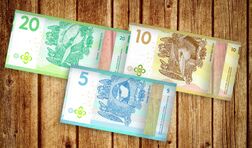 Banknotes of 5, 10 and 20 pounds. | |
| ISO 4217 | |
| Unit | |
| Plural | Lirae (Ladino), Punts (Polish), Pfund (Dutch) |
| Nickname | Kudo: 1 pound, Kilo: 1000 pounds, De Oro (of gold): banknote of 10 pounds. |
| Denominations | |
| Subunit | |
| 1/100 | Deno (Ladino), den (Polish & Dutch) |
| Plural | |
| Deno (Ladino), den (Polish & Dutch) | deni (Ladino), deny, denów (Polish), den (Dutch) |
| Banknotes | |
| Freq. used | 5, 10, 20, 50 pounds. |
| Rarely used | 100, 200 pounds. |
| Coins | 5, 10, 50 deni, 1, 2, 5 pounds. |
| Demographics | |
| User(s) | kamany |
| Issuance | |
| Central bank | Kambank |
| Website | www |
| Mint | Kambank |
| Website | www |
The Kamanian Pound (Ladino: Lira; Polish: Punts; Dutch: Pfund) is the currency of Kamany. Kambank, the central bank of Kamany, issues banknotes and coins. It is divided into 100 deni. The official symbol, L. , is widely used by businesses and advertisers in all languages.
The Kamanian Pound was first issued in 1875 when it replaced the Kamanian Florin. After a period of hyperinflation in 1922-1923, a second version of the Pound was issued in March 1924. In 1955, a third version of the Pound was issued. It stayed in use until the 1st of July 2019 when the last version started to circulate.
History
Kamanian Florin
The Kamanian Florin was established in 1848 after the implementation of the first federal constitution. According to this plan the Federal Bank of Kamany (Banko Federal de Kamnia) is established in 1849 in Kama in order to oversee cash circulation in the country and produce the new national currency. In 1850 the first coins are minted in denominations of 1/10 (1 gram of silver), 5/10 and (5 grams of silver) and 1 Florin (10 grams of silver) but local coins continued to circulate for smaller denominations. In 1852 small bronze coins in value of 1 deno (1/200 of a florin), 5 deni (1/40 of a florin) and 10 deni (1/20 of a Florin), larger silver coins of 2 Florin (20 g of silver) and gold coins of 10 Florin (6.729g of gold) were issued to complete the coinage. Foreign and former local coins were withdrawn in 1859.
First Kamanian Pound
In 1872 Kamany joined the Latin Union and decimalised its currency. The new currency, the Kamanian Pound was fixed at 5 grams of steel and 0.31 gram of gold. A new coinage respecting standards of the Latin Union was then issued thsi year in bronze (1 and 2 deni), cupronickel (5, 10 and 25 deni), silver (1/2, 1, 2 and 5 pounds) and gold (10, 20, 50 and 100 pounds). Banknotes of 100, 500 and 1000 pounds were later issued by the central bank in 1879 to ease large cash transactions and from 1884 all private banknotes were demonetised. During the Great European War of 1914 the Kamanian pound accused a severe inflation and silver coins were hoarded by the population. As a consequence of that gold coins were withdrawn and banknotes in denominations of 1, 2, 5, 10, 20 and 50 pounds were issued in 1915. Suffering from an even higher inflation after the war, banknotes in large denominations (up to 1,000,000 pounds) were issued until a redenomination of the currency in 1923. To cope with a shortage of coins and banknotes municipalities and provinces issued emergency banknotes.
Second Kamanian Pound
In 1923 the second Kamanian pound was issued at a rate of 1000 old ones. Inflation eroded the value of this second pound and by 1949 it already lost 99% of its value.
Third Kamanian Pound
In 1955, the new pound was introduced, worth 100 old pounds and 1/5 dollar. Aluminium 1, 5, 10 and 20 deni, stainless steel 50 deni and 1 pound, and silver 2 and 5 pounds were introduced. Old coins and banknotes continued to circulate along new ones. Inflation eroded the value of the pound and 1 deno coins were rapidely out of use.
During the 1960s silver coins were demonetised as they were hoarded and 5 pound-coins were replaces by stainless steel counterpart in 1967. At the same time new banknote were issued in values of 5, 10, 50, 100 and 500 pounds. In 1973 a denomination of 20 pounds was issued.
Fouth Kamanian Pound
The 1st of July 2019 a new version of the Kamanian pound was issued, worth 1000 old pounds and 1.3 dollar.
Coins
| 2019 series | ||||||
|---|---|---|---|---|---|---|
| Image | Value | Metal | Diameter | Mass | Edge type | |
| Obverse | Reverse | |||||
| 5 deni | stainless steel | 20.5mm | 3.9 g | Reeded | ||
| 10 deni | stainless steel | 23 mm | 5 g | Reeded and smooth | ||
| 50 deni | Nordic gold | 21.2mm | 4.2g | Smooth | ||
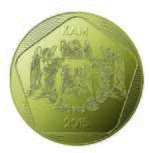
|
1 Pound | Nordic gold | 26.3mm | 6,9g | Reeded | |
| 2 pounds | Ring: Nordic gold, centre: stainless steel | 22.3mm | 6.5g | Reeded and smooth | ||
| 5 pounds | Ring: Nordic gold, centre: stainless steel | heptagonal, 26.29mm | 7g | Smooth | ||
Banknotes
| Birds series | |||||
|---|---|---|---|---|---|
| Image | Value | Main Colour | Description | ||
| Obverse | Reverse | Obverse | Reverse | ||
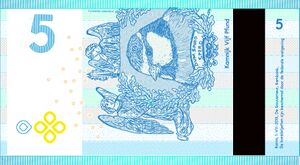
|
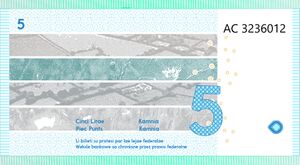
|
5 Pounds | Blue | Eurasian blue tit and coat of arms of Kamany | Abstract designs representing fields and plains of Kamany |
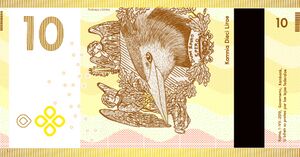
|
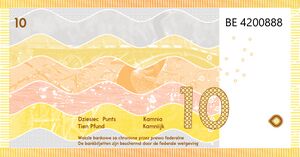
|
10 Pounds | Yellow | Great crested grebe and coat of arms of Kamany | Abstract designs representing wetlands of Kamany |

|
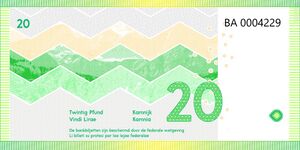
|
20 Pounds | Green | European green woodpecker and coat of arms of Kamany | Abstract designs representing hills and mountains of Kamany |
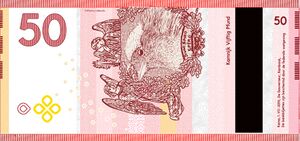
|
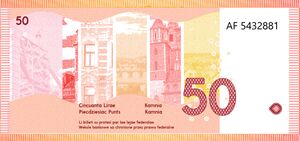
|
50 Pounds | Red | European robin and coat of arms of Kamany | Abstract designs representing cities of Kamany |
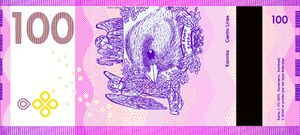
|

|
100 Pounds | Purple | Eurasian siskin and coat of arms of Kamany | Abstract designs representing winds and life in the sky of Kamany |
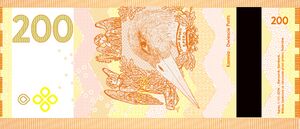
|

|
200 Pounds | Orange | White stork and coat of arms of Kamany | Abstract designs representing cultures and traditions of Kamany |